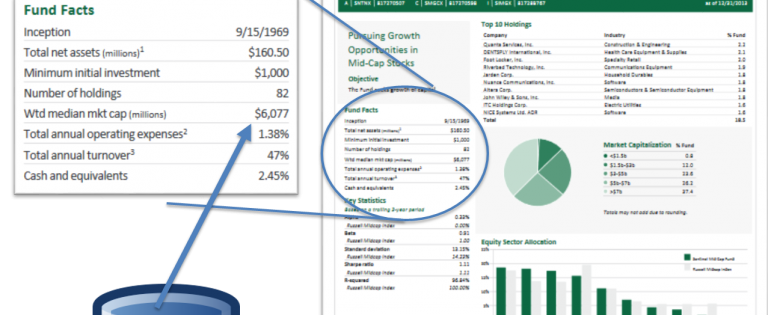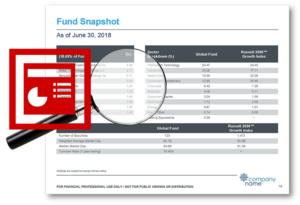Business Rules: What They Are and Why You Need Them for Investment Marketing Content Automation

Hi, I’m Kim Rebecca. Throughout my career in the global asset management industry, I’ve had the opportunity to help facilitate data-heavy content automation. I’ve done this on thousands of regulatory documents, marketing collateral, presentations, web pages and so on. Actually, it’s probably hundreds of thousands. One of the key advantages of content automation is the accommodation of the ever-expanding scope of distribution. It allows product marketers such as myself to bolster their bragging rights. I’ve had the good fortune to help three global asset managers with their content automation efforts — prominent and well-recognized firms managing assets galore. I was thus somewhat surprised to find that a common challenge in the implementation phase of all of their automation was something seemingly basic: the identification and articulation of something called business rules.
What are ‘business rules’ anyway?
The term “business rule” is common terminology for formally trained project managers. This includes PMPs, particularly when the projects involved encompass technology, as content automation does. Business analysts and exec-level marketing leadership are also well versed in business rule lingo. It may not, however, be a familiar term to marketing middle management. Even so, these are the people typically tasked with implementing content automation at an average asset manager. When asked by the automation vendor for their business rules, a product marketing manager might very well draw a blank.
So, what exactly, are business rules? Put simply, business rules are statements that give the criteria and conditions for making a decision. If this, then that. Let’s say you’re playing in a football game. It’s the fourth down. The game is tied, and there are less than two minutes left. Your opponent is the New England Patriots. If you run toward the end zone and don’t kick the ball, then you risk giving it back to Brady. Or, in the content automation world, if the source data comes to the automation vendor in Excel and for one quarter there’s a random blank cell, then the asset manager’s data team must be alerted of a potential error. (In this example, the rule would also likely delineate how that notification would happen)
Why are they needed to automate investment marketing content?
Prior to implementation, you’ll need to assess and account for the time, scope, money and human resources needed to get automation up and running. Here are a few reasons why:
They’ll keep you on schedule.
Avoid identifying business rules on an ad-hoc basis in the midst of your implementation phase. Thoroughly vet your business rules before passing them along to — and paying for — your vendor to translate them into code. Surprisingly, internal business partners want to weigh in on even the most innocuous business rule. Identification and vetting business rules ahead of time will make a huge difference. It’ll prevent your implementation from extending from two quarters to two years. I’ve seen that happen.
They’ll keep you competitive.
Part of the process will likely involve examining how the competition presents its data. How many decimals do they use? Do they use pies, bars, or other visuals? How do their performance tables reformat as time periods are added or removed? And by examining the standard, you can also reset it. Envision a factsheet like no other.
They’ll mitigate risk.
Business rules link closely to governance. If they weren’t identified from existing governance procedures already in place, they can actually be used as the blueprint for procedural documents going forward. This aids in transparency (always important in the highly regulated world of asset management) and all but eliminates key person risk.
They’ll create efficiencies.
It’s likely in the process of gathering and vetting your business rules, you’ll spot opportunities where they can be multi-purposed across collateral type, distribution channel, product type. Some might apply to both print and web displays, for example. Others might apply to both retail and institutional products, or perhaps even those sold abroad. The more thorough you, the more applications you and your stakeholders will undoubtedly uncover.
How to identify content automation business rules — some hints
A good content automation vendor will provide you with tools and guidance on putting together your business rules, but here are a few things to keep in mind.
- Brainstorm with all current project managers and all internal business partners — many business rules are simply in their heads. I like doing this in a group setting; memory-jogging potential is maximized.
- Meticulously document all activities throughout a manual production cycle and have your key stakeholders do the same.
- Review your current policies, procedures, and standards. For example, business rules on how certain data should appear on a fact sheet may very well already be spelled out in your Creative Department’s standards manual.
- Interview your automation vendor’s project manager. Possibly talk to their other clients who already completed implementation and are open to conversation.
Vetting your content automation business rules — some recommendations
Every firm has its own personality and its own customs when it comes to building cross-departmental consensus. That said, I’d like to offer some helpful suggestions regardless of when and where they’re employed in the conversation.
- Put together a worksheet that lists each proposed business rule, the rationale for the rules, potential multiple applications of the rules, interested parties, etc… Ask your automation vendor if they have a template like this already waiting in the wings.
- Create visual aids. Illustrate how a business rule will dictate how a data point appears on a fact sheet, web page, and/or presentation. Visual aids help stakeholders envision what you’re talking about. It’s pretty amazing how many different representations of the same data exist even within a single firm. Such visual mapping is extremely helpful for those who don’t know your marketing materials minutiae. Having a visual associated with a business rule helps prompt connections to other rules you may have missed conceptually.
- Confirm that you have the correct stakeholder sign off. Sometimes the person signing is not high enough on the bureaucratic totem pole. Sometimes they’re too high and some of the details they don’t know are critical to the decision at hand.
- Hate to say it, but have a meeting. Have a meeting for business rules that elicit strong opinions or cannot be expeditiously ironed out in an email to establish consensus. Bring your copies of your worksheet and your visual aids for all participants and/or project them; this will help facilitate the conversation.
- Finally, it will also behoove you to discuss, create, and document procedures for adding/modifying business rules. This scenario will inevitably arise, and an established, agreed-upon procedure helps integrate any changes smoothly and swiftly.
One final note — keep a 3-D perspective
Because the term “business rule” is IT vernacular, business rules in content automation projects almost exclusively address data-related matters. But consider this: business rules in our context are created with a final marketing vision in mind. Is your final vision of a factsheet merely a sheet of paper or a PDF displaying a bunch of numbers? Of course not. It needs to be attractive and legible, it needs to support your brand, it needs to be compliant! In the content automation world, business rules must be three-dimensional, or 3D: they must address Data, of course, but also Design and Disclosure. Content automation business rules should be all-inclusive. Well done rules will provide guidance on anything from data presentation to color specifications for a bar chart. So, when gathering and vetting your business rules, keep this big, 3D picture in mind.
This post is part of our series on Best Practices for Implementing Content Automation. To be notified when new posts are published on this topic, please subscribe to receive our emails.
Here are some related resources that might interest you: From the Blog: Four Ways Asset Management Marketers Can Grow AUM |  From the Blog: How much does it cost to automate factsheets? 🧐 |  From the Blog: 7 Problems With Automating Factsheets In PowerPoint |




 Compare the Top 3 Finserv Content Automation Vendors [White paper]
Compare the Top 3 Finserv Content Automation Vendors [White paper] Create Pitchbooks the Drive Sales [White paper]
Create Pitchbooks the Drive Sales [White paper] Build vs. Buy: Should Your Financial Services Firm Outsource or Insource Marketing Technology? [White paper]
Build vs. Buy: Should Your Financial Services Firm Outsource or Insource Marketing Technology? [White paper]  10 Tips for Rebranding your Fund Marketing Documents [White paper]
10 Tips for Rebranding your Fund Marketing Documents [White paper]



